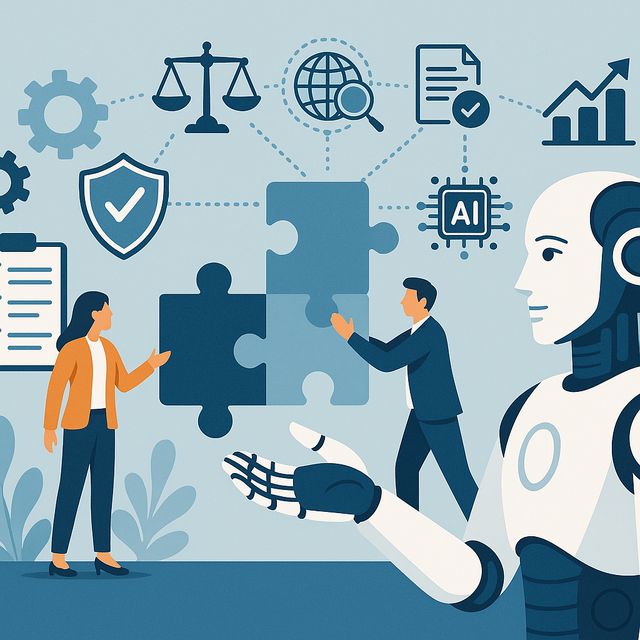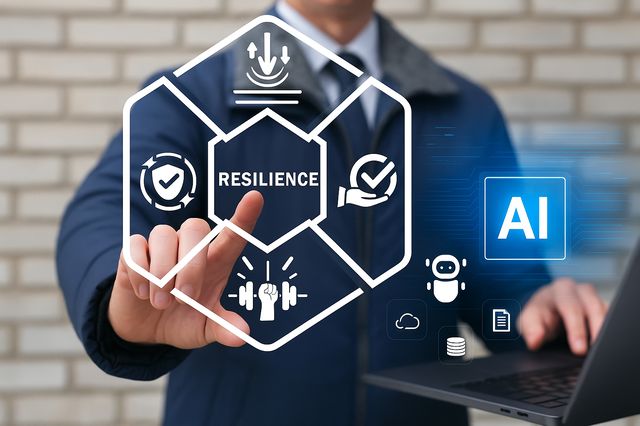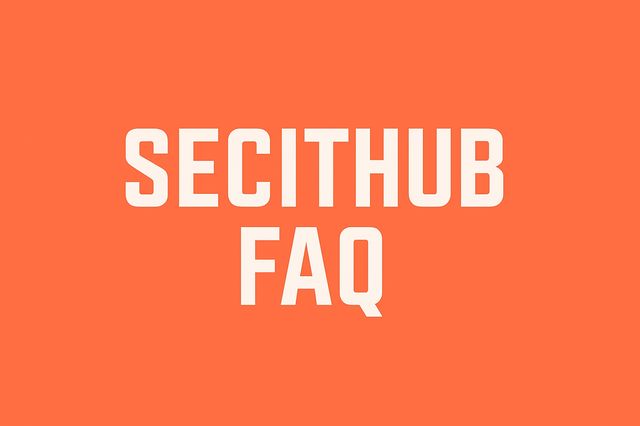GRC and AI resilience refers to how Governance, Risk & Compliance frameworks are adapting to the rise of artificial intelligence.
In 2025, the most resilient organizations embed AI oversight into every layer of governance ensuring transparency, accountability, and trust across automated decisions and intelligent risk systems.
Introduction
Artificial Intelligence is no longer a future concern it’s a present-day compliance challenge.
As AI systems drive decisions across finance, healthcare, and cybersecurity, traditional GRC models struggle to keep up with algorithmic complexity, regulatory velocity, and ethical ambiguity.
The question isn’t whether AI will reshape GRC it already has.
The real challenge is how governance can evolve fast enough to manage intelligent risk without losing human accountability.

The Shift from Traditional GRC to AI-Embedded Governance
AI Becomes a Core Governance Domain
According to Riskonnect, organizations should not treat AI governance as a separate discipline, but as an extension of existing GRC frameworks embedding oversight, transparency, and risk controls directly into AI operations.
This means defining who owns AI models, how they are validated, and how their risks are monitored throughout the lifecycle.
SwissGRC has already implemented this concept through its AI-GRC module, which manages use-case conformity, AI taxonomy, lifecycle audits, and continuous monitoring. It aligns with frameworks such as the EU AI Act, NIST AI RMF, and ISO 42001, ensuring auditability at every step.
Sentrient reinforces that GRC must evolve from reactive compliance to proactive governance, capable of learning and adapting alongside AI systems.
Why It Matters
Without integrating AI oversight, organizations face new blind spots from model drift and bias to opaque decision-making.
To stay credible and compliant, GRC teams must move from post-event auditing to real-time model governance.
Global GRC Market (2025–2030) (USD Bn)
| Year | Enterprise GRC Market | GRC Software Segment | CAGR (%) | Key Drivers |
|---|---|---|---|---|
| 2025 | 72.42 | 21.04 | — | Regulatory expansion · Cyber & Operational Resilience · Cloud adoption |
| 2026 | 81.96 | 23.82 | 13.2 | Integration of AI governance tools · RegTech growth |
| 2027 | 92.77 | 26.93 | 13.2 | Unified GRC platforms · ESG and DORA compliance |
| 2028 | 104.98 | 30.45 | 13.2 | Continuous risk monitoring · AI-driven automation |
| 2029 | 118.73 | 34.43 | 13.2 | Real-time reporting · Predictive analytics in risk |
| 2030 | 134.86 | 37.71 | 13.2 | Global standardization · AI resilience becomes mainstream |
Sources | Grand View Research – Enterprise GRC Market Forecast to $134.86 B by 2030 (CAGR 13.2 %)
Mordor Intelligence – GRC Software Market $21.04 B (2025) → $37.71 B (2030)
Disclaimer Data adapted from publicly available industry reports for educational and analytical use only. All rights to original research remain with their respective owners.
The Core Principles of AI-Resilient GRC
Governance Guardrails
Define what models can do, who can deploy them, and how accountability is enforced.
Riskonnect advises embedding these guardrails inside the existing GRC architecture rather than creating standalone AI silos.
Lifecycle Integration
AI oversight must span design, training, deployment, and validation.
SwissGRC’s system demonstrates this through automated model health checks and conformity scoring.
Continuous Monitoring & Explainability
AI models evolve and so must compliance.
Riskonnect emphasizes continuous oversight of bias and performance, generating auditable trails for every AI decision.
Defined Accountability Lines
AI governance fails without human ownership.
Organizations must clearly define responsibilities across Legal, IT, Data Science, and Compliance teams.
Transparency, Ethics & Trust
SwissGRC highlights explainability and traceability as the pillars of AI-resilient GRC.
Models must be interpretable stakeholders must understand how decisions are made.
Ethical and explainable AI isn’t just a compliance checkbox it’s the foundation of trust.
AI Resilience & Governance within GRC (2024–2029) (USD Bn)
| Segment | 2024 Value | 2029 Projection | CAGR (%) | Focus Area |
|---|---|---|---|---|
| AI Governance & Ethics | 2.3 | 14.9 | 45.3 | Responsible AI policies · Bias detection · Regulatory alignment |
| AI-Driven Risk Detection | 1.8 | 10.3 | 43.7 | Fraud analytics · Anomaly detection · Threat forecasting |
| AI Compliance Automation | 2.6 | 14.0 | 41.8 | Continuous audit · Regulatory reporting · Real-time validation |
Sources | Markets and Markets – AI Governance Market $890.6 M (2024) → $5.776 B (2029), CAGR 45.3 %
Allied Market Research – AI in Risk & Compliance 2024–2029 Forecasts
Disclaimer Data adapted from publicly available industry reports for educational and analytical use only. All rights to original research remain with their respective owners.
How AI Strengthens (Not Replaces) GRC
Automation of Repetitive Controls
AI can accelerate document reviews, policy mapping, and risk classification — freeing compliance officers to focus on strategy.
Predictive Risk Analytics
Machine learning enables predictive modeling, identifying emerging risks before escalation.
AI augments human insight by correlating datasets traditional GRC tools can’t process.
Decision Intelligence for Compliance
Natural language processing allows AI systems to synthesize new regulations, assess control gaps, and recommend remediations.
Key Insight
AI doesn’t eliminate GRC it amplifies it.
It automates the mechanical so humans can focus on the ethical.

The Future of GRC Professionals in the AI Era
Emerging Skill Sets
GRC professionals must now combine technical literacy with ethical reasoning:
AI fundamentals and model governance
Data privacy and algorithmic accountability
Understanding of EU AI Act, NIST AI RMF, ISO 42001
Risk modeling and bias auditing
Communication skills to bridge compliance and data science
New AI-GRC Roles
AI Compliance Officer
Algorithmic Risk Manager
Responsible AI Lead
AI Ethics Officer
Why GRC Is Not at Risk of Replacement
Far from being automated away, GRC becomes the human conscience of AI.
Ethical interpretation, audit accountability, and trust cannot be replaced by code.
Conclusion | From Oversight to Orchestration
AI is redefining what governance means.
In 2025, effective GRC isn’t about control it’s about orchestrating accountability between humans and machines.
The future of GRC lies in hybrid intelligence
Humans define the ethics, AI delivers the evidence, and compliance becomes continuous rather than reactive.
Organizations that embrace AI-resilient GRC won’t just meet compliance they’ll build trust as a competitive advantage.

AI automates documentation and analytics, but ethical judgment remains human.
Integrate monitoring, validation, and auditing directly into the AI lifecycle — as part of enterprise risk management.
Model drift, bias, lack of explainability, privacy violations, and poor governance.
EU AI Act, NIST AI RMF, ISO 42001, and privacy laws like GDPR or CCPA
AI literacy, ethics, transparency, collaboration, and continuous learning.
References
AI in GRC: Trends, Opportunities and Challenges for 2025 – metricstream
How to Blend AI Governance with Existing GRC Programs – oceg
The Intelligent Future of GRC: How AI is Reshaping Governance, Risk & Compliance in 2025 – cerrix
AI Resilience: A Revolutionary Benchmarking Model for AI Safety – cloudsecurityalliance



[…] approach builds security into the structure of computation itself.It’s not about firewalls or compliance checklists it’s about creating AI that’s both powerful and […]